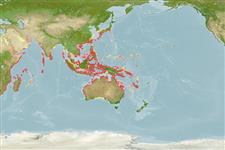Classification / Names
Common names from other countries
Main reference
Size / Weight / Age
Max length : 13.0 cm TL male/unsexed; (Ref. 4392)
Environment
Marine; reef-associated; depth range ? - 18 m (Ref. 90102)
Climate / Range
Tropical, preferred ?; 35°N - 33°S, 32°E - 168°E
Distribution
Indo-West Pacific: Persian Gulf (Ref.80050); Red Sea and East Africa to Papua New Guinea, south to Lord Howe Island. Unknown from Micronesia.
Countries | FAO areas | Ecosystems | Occurrences | Introductions
Short description
Dorsal
spines
(total): 9;
Dorsal
soft rays
(total): 11;
Anal
spines: 3;
Anal
soft rays: 11. True form has interrupted mid-lateral stripe. Female with yellow stripe from the tip of snout to just past axil, running below eye where pale silvery-blue; male with continuous mid-lateral line and dark 'ear' (Ref. 48636).
IUCN Red List Status (Ref. 115185)
Threat to humans
Harmless
Human uses
Fisheries: of no interest; aquarium: commercial
More information
ReferencesAquacultureAquaculture profileStrainsGeneticsAllele frequenciesHeritabilityDiseasesProcessingMass conversion
Tools
Special reports
Download XML
Internet sources
Estimates of some properties based on models
Phylogenetic diversity index
PD50 = 0.5010 many relatives (e.g. carps) 0.5 - 2.0 few relatives (e.g. lungfishes)
Trophic Level
3.4 ±0.3 se; Based on diet studies.
Resilience
High, minimum population doubling time less than 15 months (Preliminary K or Fecundity.)
Vulnerability
Low vulnerability (23 of 100)
Price category
